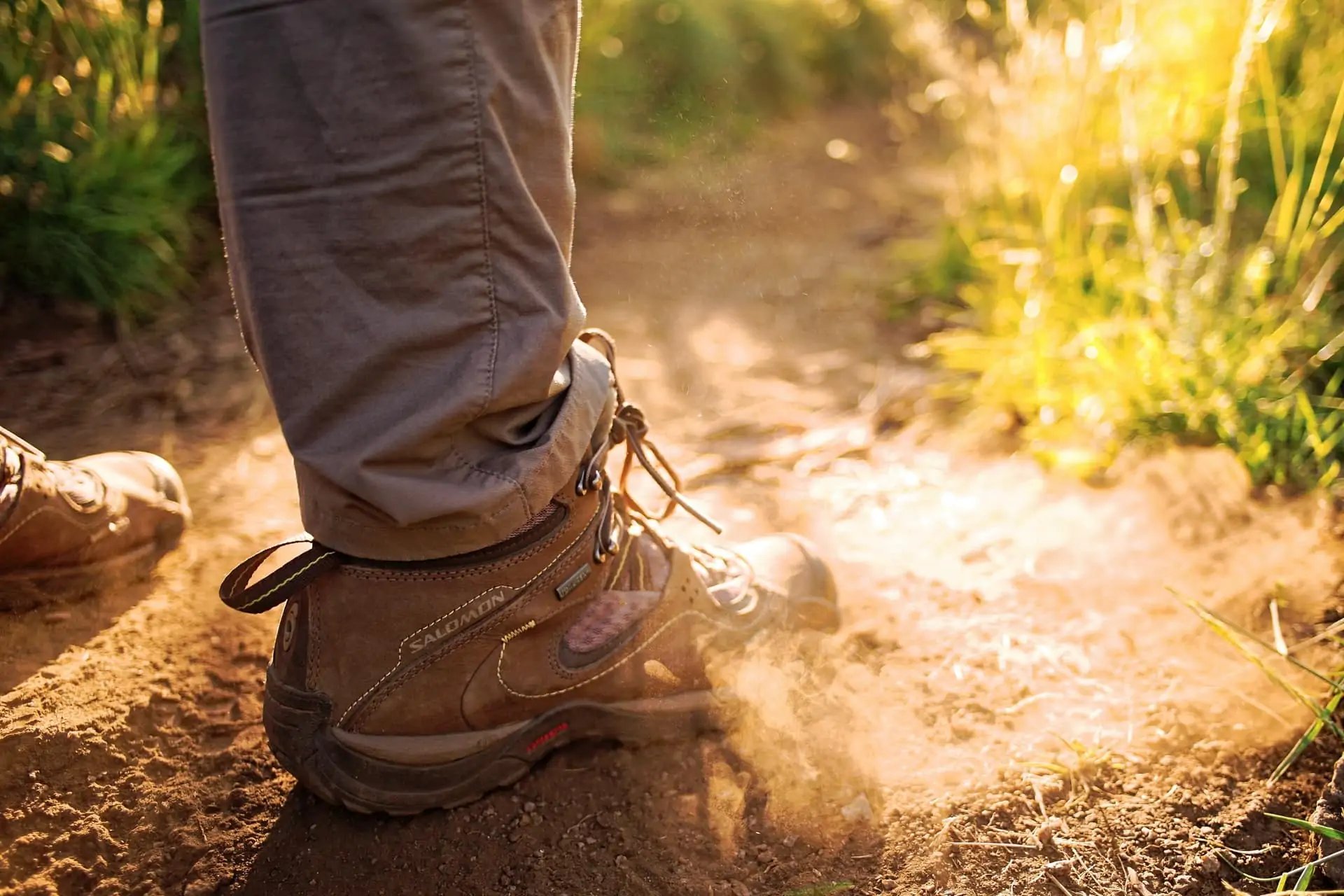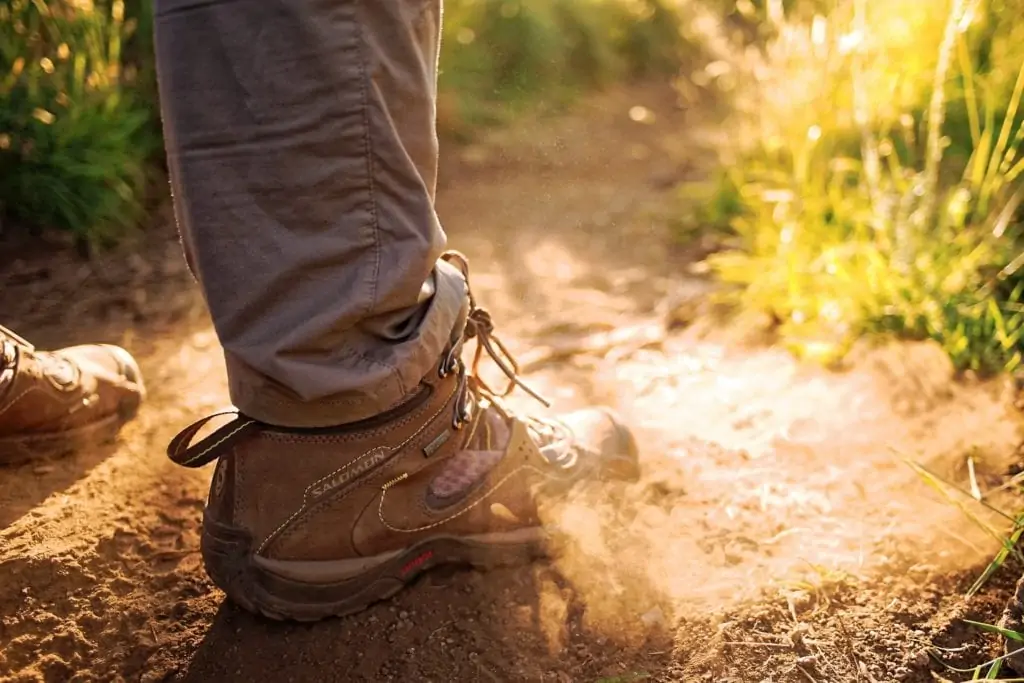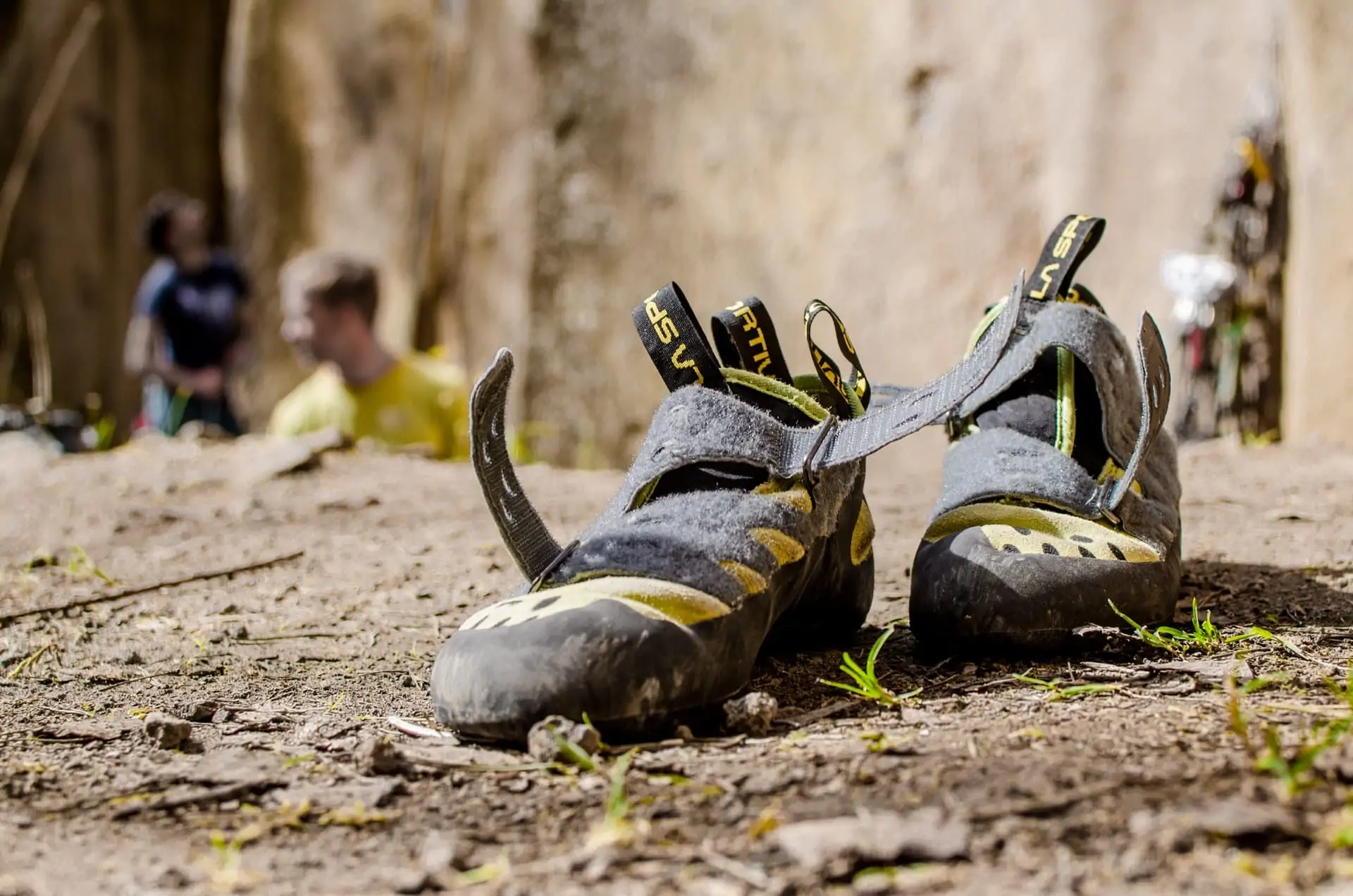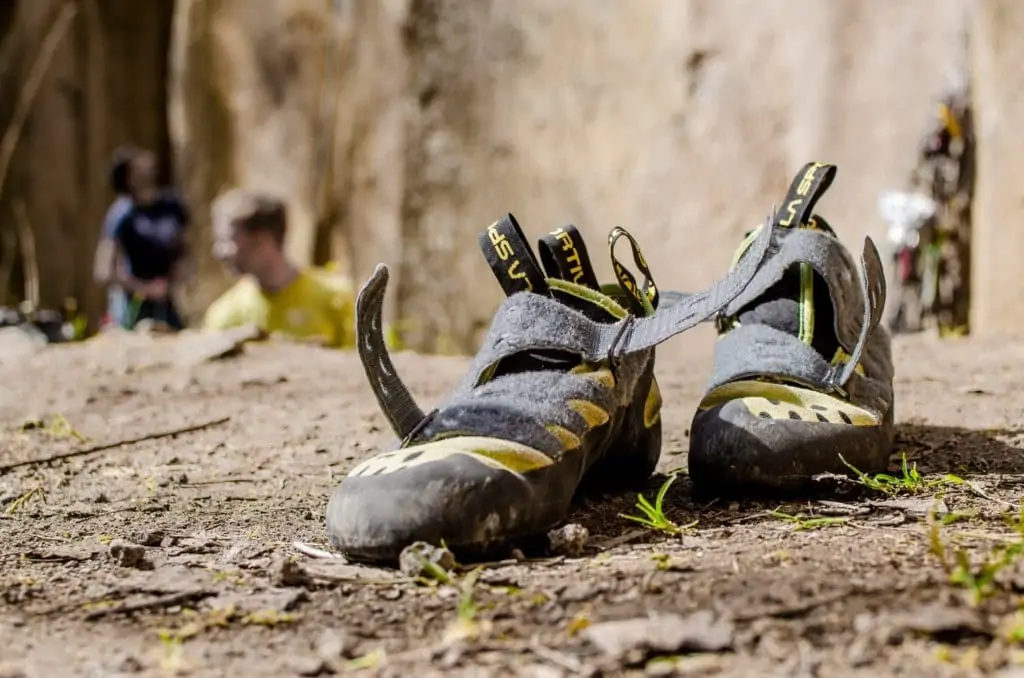So you’re just getting into climbing, and you tell your buddy that you want to buy your own shoes. Your buddy says that you should get the tightest shoes you can because that’ll help your climbing the most. That doesn’t sound like the most pleasant experience for you. Who wants to be in pain all day?
If you’re not sure how your climbing shoes should fit, you’ve come to the right place. We’re going to break down some of the common misconceptions about climbing shoes and give you some tips for how they should fit. Don’t worry; you won’t be stuck wearing the smallest shoes you can fit your feet into!
 How Should Climbing Shoes Fit?
How Should Climbing Shoes Fit?
Overall, climbing shoes should minimize the amount of empty space around your feet, as more empty space is likely to rub and create blisters. In order to achieve this type of fit, you have to take into account a variety of factors, such as the width of your feet and how aggressive of shoes you want. These factors may help to direct you towards some shoes and away from others. Climbing shoes should fit snuggly, but they should not be constricting your blood flow.
If you have wider feet, a lace-up climbing shoe is probably the way to go. Lace-up shoes are more customizable in the fit than either slipper shoes or velcro shoes. Luckily for you, many popular shoes are now made in both velcro and lace-up options.
If you have narrow feet, velcro or slipper shoes may fit your feet better. Sometimes lace-up shoes just have too much string for smaller and more narrow feet. Another thing you can do if you have more narrow feet is to look at women’s shoe models. In general, women’s climbing shoe models have a smaller heel box and tend to fit narrower feet better.
The main differences between men’s and women’s models are the width of the shoe and the colors the shoes are sold in. We recommend that you take the time to try on both models, in case one fits you better than the other. Some men’s feet fit better into the women’s models, and some women’s feet fit better into the men’s models. Don’t be afraid to try them all!
The next thing to think about is how aggressive you want your shoes to be. If this is your first pair of climbing shoes, try to find a good pair of neutral shoes. Neutral shoes tend to be more comfortable and have thicker rubber, so they will last longer. As you start to narrow in on specific styles of climbing that interests you, you can pick a style of shoe that will be more helpful for that. For example, if you love steep overhanging climbs, then maybe aggressive climbing shoes with harshly downturned toes may be your next pair.
Don’t fall into the trap of thinking that all good climbers wear a certain type of style of shoe.
Every climber is different, and every climber’s feet are different. What each climber requires of their shoes helps them determine what style of shoe to get, but it is ultimately the fit that matters.
Take time to find what fits you best and will work best for you. You may find our guides on shoes helpful:
- The Best Shoes for Indoor Climbing Gyms
- The Best Beginner Climbing Shoes
- The Best Intermediate Climbing Shoes
How Tight are Climbing Shoes Supposed to Be? Should Your Toes be Curled?
Your climbing shoes shouldn’t force your toes to curl up. If they do, you may be in so much pain that you can’t even focus on climbing! Overall, climbing shoes should be snug, but if you can’t stand in them, you won’t be able to climb in them either.
A good rule-of-thumb is that your toes should be touching the end of your shoes, but not curled up or painful.
The best time of day to go shopping for climbing shoes is in the afternoon when your feet are slightly more swollen than when you wake up. That way, you are less likely to think the shoes fit in the store, but then get home and have them be too tight to use.
Should Climbing Shoes Hurt when Worn?
No, but also sort of yes. Climbing shoes shouldn’t hurt, but they should be very snug. They’re not the type of shoes that you would ever willing wear for a whole day. Most climbers only wear their shoes when they’re actually climbing. People tend to change into more comfortable sneakers or belay shoes to hang out and belay. That way, your climbing shoes can fit for performance, not necessarily comfort.
That being said, your shoes shouldn’t outright hurt. If your knuckles are bent or pushing against the top of your shoe too much, it can be uncomfortable and cause rubbing.
If your toes are curved over in your shoes, it can be uncomfortable and make standing or climbing nearly impossible. Think about it, if you don’t take care of your feet, how will you climb? Taking care of your feet starts with finding the right climbing shoe for your feet and needs.
What Size Climbing Shoe Should You Buy?
Most often, climbing shoes are sold in European shoe sizes, but the equivalent of your normal street size is a good place to start. Most climbing companies have a conversion sheet somewhere on their website that is specific for their shoes. You will almost certainly have to try on multiple pairs of shoes before you find the right fit. There is no perfect answer to what size climbing shoe you should wear. It all depends on the shape of your feet.
We recommend trying on climbing shoes in a place where you can use them a little. Most large scale places that sell climbing shoes will have a few small things that you can stand on to mimic climbing. Some even have small bouldering walls that you can climb around on. This allows you to move around a little in the shoes. Not only does this let you test the fit, but it also enables you to see how the model of shoe you’re trying on preforms.
Here are some links to some common rock climbing shoe size charts:
How do Climbing Shoe Sizes Convert from Normal Shoes?
Climbing shoes are sold in European sizes and half sizes, but each specific model of climbing shoe will fit differently. For example, you could wear a size 38 in one model of shoe and a 39.5 in a different model. It’s all about how your feet fit each model. Don’t be stuck to one shoe size, especially since European sizes have smaller changes between each size, so you can work to get the best fit possible.
Should Climbing Shoes Always be a Size Smaller?
One of the most common things you might be told when you start climbing is to go a size down from your normal shoes. This can work for some people and with some models of climbing shoes, but certainly not everyone.
It is way more important to find shoes that fit the shape of your feet and are comfortable than are the smallest things you can fit your feet into.
This age-old adage of going a size down with your climbing shoes comes from years ago when climbing shoes were not nearly as tapered and shaped as they are today. Climbing shoes started out more like boots and have slowly become smaller and more fit to your feet, due to developments in materials and production abilities. This means that squeezing into the smallest shoe possible is no longer a good idea. In the past, this might have helped climbing, but now it’s more likely to hurt climbers.
So, if you find climbing shoes that fit your feet, don’t let your friend convince you that wearing the next size down will improve your climbing. If anything, it could harm your climbing to size down from what’s comfortable for you.
Is Wearing a Smaller Climbing Shoe Dangerous?
A smaller climbing shoe can cause some pretty serious health issues for your feet, as well as just being painful to wear. A painful shoe can also distract you from your climbing, leading to a higher potential of falling and hurting yourself.
If your climbing shoe squishes your feet too much, it can lead to some pretty serious long-term health risks to your feet. This can include nerve damage, corns, bunions, crossed-over toes, bleeding under toenails, and bacteria or fungi growth. While wearing a climbing shoe that is too big may not be great for your climbing, a shoe that’s too small can lead to health risks, so putting in the time to find the right fit of climbing shoe is extremely important.
Can I Wear Socks with my Climbing Shoes?
The rationale behind not wearing socks with climbing shoes is that it adds another layer of material between your foot and the rock, thus minimizing how much feel you have with your feet. Many people like to wear socks with rental shoes, but once you invest in your own shoes, it no longer makes as much sense to wear socks. If you put in the time and effort to fit good fitting shoes, socks no longer help the fit and may actually hinder your feel of the rock.
If you want to get more life out of slightly stretched out shoes, adding thin socks might be a potential way to make the shoes continue to fit. Wearing socks with your climbing shoes is not a dangerous thing, it’s just generally not done. That being said, if you are the most comfortable when wearing socks, then by all means, go for it.
If you would like to know more about how to make your existing climbing shoes fit better, check out our other articles on how to stretch and how to shrink your climbing shoes.
Wrapping Things Up: How Should Climbing Shoes Fit?
Overall, climbing shoes should be snug but not painful.
In the end, it isn’t the specific size you wear that matters, but how the shoe feels on your foot. Pain doesn’t equal gain and can often detract from your climbing, so make sure that your feet are comfortable.
Finding the perfect climbing shoe can be a long process of trying on many, many shoes, but don’t get discouraged! There’s a shoe out there that will fit you; you just have to put in the time and effort to find it.
If you found this post helpful, you’re definitely going to like our other climbing tips here.
> When to Resole Climbing Shoes?
> How to Clean Rock Climbing Shoes

 How Should Climbing Shoes Fit?
How Should Climbing Shoes Fit?










